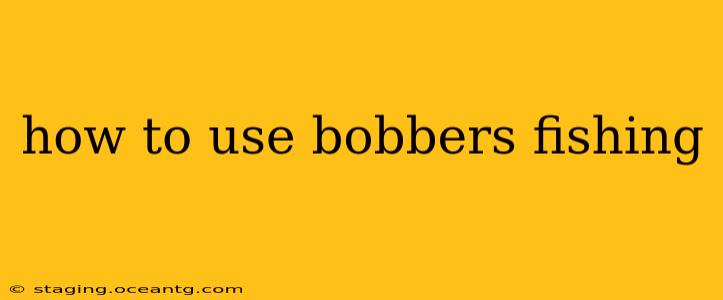Bobbers, also known as floats, are essential tools for many anglers, especially when fishing in calmer waters. They indicate when a fish bites, making them incredibly useful for both beginners and experienced fishermen. This guide will walk you through everything you need to know about using bobbers effectively, from choosing the right one to mastering various techniques.
What are Bobbers and How Do They Work?
Bobbers are buoyant devices attached to your fishing line above the hook. They float on the water's surface, allowing your bait to suspend at a specific depth. When a fish bites and takes the bait, the bobber will submerge, dip, or move significantly, signaling you to set the hook. Different types of bobbers are designed for various fishing situations and depths.
Choosing the Right Bobber
Selecting the appropriate bobber depends on several factors:
- Water Conditions: Calm waters allow for smaller, more sensitive bobbers. Rougher water requires larger, more stable bobbers that can withstand waves and wind.
- Bait Size and Type: Larger baits often necessitate larger bobbers to support their weight. Smaller, lighter baits work well with smaller bobbers.
- Fishing Depth: You'll need different bobber lengths to fish at varying depths. Adjustable bobbers offer versatility in this regard.
- Fishing Style: Some bobbers are designed for specific techniques, such as slip bobbers for drifting or fixed bobbers for stationary fishing.
Types of Bobbers
Several types of bobbers are available, each with its unique characteristics:
- Slip Bobbers: These allow the bobber to slide up and down the line, enabling you to adjust the depth easily. Ideal for targeting fish at various levels within the water column.
- Fixed Bobbers: These are secured at a specific point on the line, maintaining a constant depth. Suitable for fishing in shallower areas or when precise bait presentation is crucial.
- Surface Bobbers: Designed to sit on the water's surface. These are great for topwater fishing or when using live bait.
- Subsurface Bobbers: These bobbers are partially submerged and are often used for fishing at a specific depth beneath the surface.
How to Rig a Bobber
Rigging your bobber correctly is crucial for success:
- Attach the Bobber Stop (if using a slip bobber): Slide a bobber stop onto the line, positioning it to control the bobber's depth.
- Attach the Bobber: Secure the bobber above the bobber stop (slip bobber) or directly onto the line (fixed bobber) using the appropriate method indicated on the bobber packaging.
- Attach the Swivel (optional): Using a swivel helps prevent line twist, especially important when using slip bobbers.
- Add a Weight (optional): If using a slip bobber, you'll likely need a weight (e.g., split shot) to keep the line taut and the bait at the desired depth.
- Attach the Hook and Bait: Connect your hook to the line and add your bait.
What to Look for When a Fish Bites
The behavior of your bobber indicates a fish bite. Here's what to watch for:
- Submersion: The bobber will completely disappear beneath the surface.
- Sudden Dip: A rapid downward movement of the bobber signifies a strike.
- Dragging: A slow, steady movement of the bobber to the side indicates a fish is pulling on your line.
- Tugs: Small, jerking movements suggest a fish is nibbling at the bait.
When you observe any of these signs, set the hook with a firm, upward motion.
How to Set the Hook
Setting the hook efficiently is vital for success:
- Maintain Line Tension: Keeping the line taut before setting the hook increases your chances of a successful catch.
- Firm, Upward Jerk: Once you detect a bite, swiftly lift your rod tip upwards to securely hook the fish.
- Avoid Over-Setting: Don't yank excessively; a strong yet controlled motion is key.
Troubleshooting Common Issues
- Bobber Not Floating: Check for any damage to the bobber or ensure the line is not snagged.
- Fish Not Biting: Try adjusting your bait, depth, or location.
- Losing Fish: Ensure your hook is sharp and properly set. Consider using stronger line for larger fish.
Mastering the art of bobber fishing takes practice, but by following these tips and learning from your experiences, you'll be reeling in fish in no time! Remember to always practice safe and ethical fishing practices.
